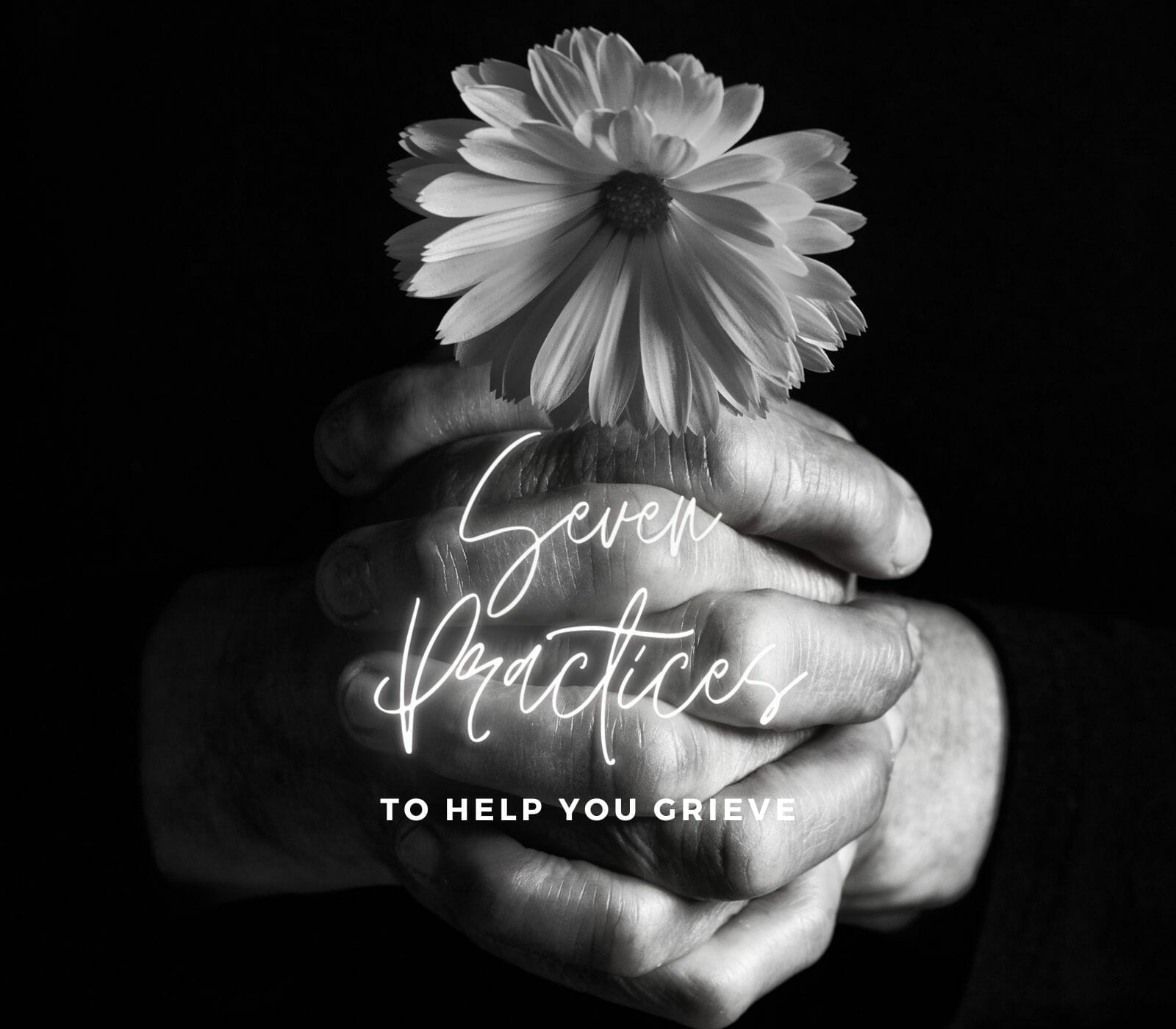Seven Practices to Help You Grieve

Many of us grieve lost threshold moments such as graduations, wedding ceremonies, and the celebration of lives and memorials. All of us grieve for what we never had and needed.
Seven Practices to Help You Grieve
by Claire B. Willis
As we emerge from the ‘’complete quarantine’ quarantine’ of Covid and move toward more connection with one another, many of us are carrying grief from the last year. Perhaps you lost a loved one, a friend, parent, child from Covid. Maybe you experienced a different loss, a more ambiguous loss such as the loss of a pet, a parent to dementia, a loss of fertility, or someone you loved succumbed to addiction. Many of us grieve lost threshold moments such as graduations, wedding ceremonies, and the celebration of lives and memorials. All of us grieve for what we never had and needed.
When we don’t tend to our losses, they return over and over again. Like a stray cat that leaves for a few days and then returns to be fed, grief insists that we remember and tend itGrief insists that we remember and tend it like a stray cat that leaves for a few days and then returns to be fed.
How do we hold what for many of us may experience as unbearable feelings we just want to push away, distract ourselves, and not feel the searing pain of our loss?
If we think of grief as an expression of our love that has no place to go, we may tend to it with more care, cherish it, and carry it with us, allowing it to find a place in our hearts.
But how do we do that? There are several practices that several practices not only help us build our capacity and resilience to carry grief but also help us build our capacity and resilience to carry grief and connect us more deeply to ourselves and others.
1. Begin with Kindness
Loss shocks us all, coming with an enormity that oftentimes frequently we just can’t take in. We may even be expecting a death, yet, when it happens, we can’t seem to make sense of it. Our beloved partner, parent, child, a pet was here, and now they are gone. We stand in rooms that are empty and silent.
Amidst the pain and chaos that grief ushers in, it’s its kindness, isn’t it? Isn’t it, that feels like a reliable anchor, perhaps the only reliable anchor? Imagine if you had a close friend who was grieving and struggling, and you simply reminded them to be kind to themselves. This is good medicine for the soul. Could we treat ourselves in the same way we’d be with a close friend or a child we loved who is hurting?
2. Cultivate a Meditation Practice
It’s one thing to say, be kind to yourself. It’s another thing to embody it! One of the practices that may help us be kinder to our self selves is a practice called Metta Meditation or Lovingkindness meditation. Some people call it “tender friend.” .” Its roots are in ancient traditions of Buddhism and Hinduism.
When our life has been upended by loss and grief, we tend to look ahead and catastrophize, not yet able to imagine our life going forward from now on. Or we might look back and ruminate on what was, wishing life was still the way it was. Neither But, unfortunately, neither of these thoughts will help us navigate grief.
In this lovingkindness practice, we tether our breath to affirmative phrases and send ourself ourselves blessings. As you sit with your grief, try repeating the following phrases. silently to yourself. Notice how it feels inside you as you say these words to yourself silently:
May I welcome all my feelings as I grieve
May I allow grief to soften and strengthen my heart
May I hold my sorrow with tenderness and compassion
Can you imagine sitting for a few minutes and making this a daily habit? It will help you stay present in your life.
3. Take a Love Pause
One thing this pandemic has taught us is that everything is impermanent. Perhaps in moments of pain and uncertainty, we can remember to pause and breathe with tender mindfulness. We can say, “I love you” to a spouse or partner, our children or parents, our grandchildren or grandparents, to dear friends, and even to strangers.
4. Cultivate Gratitude
There will be times when we feel that nothing is going right in our life. At those moments, consider cultivating a gratitude practice. Starting where you are, begin by pausing for 20 – 30 seconds, looking around, and noticing what is right in your life right now.
Being persistent with the good in your life helps us rewire a pattern in our brain of being habituated to the negative. But more importantly, it helps us be with and carry our grief. Taking this pause will increase our resilience to hold our sorrow. We can begin a gratitude practice by keeping a journal. Note three things, large and small, that you appreciate before bed – things that made your day go better.
This practice cultivates a spirit of contentment for what is rather than longing for what we don’t have. Our written gratitude Gratitude might be as simple as being grateful a friend called to check in on us, having clean water to drink, or waking up in a state of good health.
5. Find a Virtual or Real Community
We all need other people never more than when we’re overwhelmed by grief. We need each other for many things: to stay sane, to feel a sense of belonging, to take a break, to fix a leaking sink, to watch a movie together, to talk about the unspeakable events that have happened, to sing and to cry. We need to check-in. We need to be in the presence of others who can listen and remind us that everything changes, and someday, we’ll feel a little better.
Yet, when you’re the person grieving and isolating, it’s not always easy to reach out when you’re feeling overwhelmed with grief. So how can we balance the need and desire to take time out alone, heal, and then find ways to connect with other people?
We may take a tentative step to reach out and discover that friends who were attentive during the first few weeks after death have returned to their own lives.
What can be a lifeline, then? Some people seek out a “grief friend,” a person at church or work, or a neighbor who understands that grief doesn’t go away and who is willing to sit and listen as we cry, rage, laugh, and tell and retell our story. Maybe you join a support group and discover that others in the room are expressing their grief in the same way you are – sleeping in their loved one’s clothes, talking to the deceased, or struggling to give away their clothes.
You may be more comfortable seeking online resources. The following links offer many resources for finding community on the internet. Almost all religious and spiritual communities hold services online as well and can also be a community resource
Grieving.com
GriefHealingDiscussionGroups.com
6. Learn a New Activity
When our minds are engaged in learning or trying something new, it’s hard to grieve. It not only distracts us, but it offers us new that can be a container for our grief. One person I know started training horses at a farm near her. Another took up dog walking at her local shelter. Some have tried learning a new art form – drawing from the natural world, melting glass, working with clay, photographing one beautiful thing each day, learning to play the ukulele, and taking dancing lessons. When we do something new, the repetitive activity of the unique expression is a distraction, and it helps to lessen our anxiety and sorrow.
7. Restore in the Natural World
Most of us live in a paradox. While we have an instinct to bond and affiliate with other life forms, our work lives tie us to computers, and hand-held devices keep us indoors for much of the day. But, by nature, we are instinctively drawn to the natural world like a moth is drawn to light.
When we experience loss, when we are grieving, it is more important than ever to find ways back to the (proverbial or metaphorical) garden, to spend time in the healing power of nature.
Outside, our bodies and minds can rest, just taking in images of leaves falling from trees, clouds moving through the sky, and hearing the bird sounds surrounding us.
Researchers Rachel and Steven Kaplan write about and describe restorative environments as outdoor places that are accessible, quiet, and relatively small such as your yard or a pocket park in the city. And if there is no safe outdoor space where you live, if you are confined indoors, even in a hospital bed, you can rest in nature just looking out a window to a patch of sky or gazing at a plant indoors. It will leave you feeling less anxious and depressed.
We don’t have to leave behind those we miss, love, and grieve. But we do go on, and we make new relationships and forge new memories. Over time grief will move from searing pain to a dull ache, visiting us with less intensity, frequency, and duration.
Let’s remember that as we invite grief in as a companion, we are carrying the love for what has been lost. Making room for grief is making room for more love.
Click HERE to Connect with your Daily Horoscope on OMTimes!
Visit Our Astrology Store for Personalized Reports
About the Author
Claire B. Willis is a clinical social worker who has led bereavement, end-of-life, cancer support, and therapeutic writing groups for over thirty years. She maintains a private practice in Brookline, Massachusetts. As a lay Buddhist chaplain ordained by Joan Halifax, she focuses on contemplative practices for end-of-life care. Marnie Crawford Samuelson is the co-author of Opening to Grief: Finding Your Way from Loss to Peace and the author of Lasting Words: A Guide to Finding Meaning Toward the Close of Life. OpeningtoGrief.com
OMTimes is the first and only Spiritually Conscious Magazine. Follow Us On Facebook, Twitter, Instagram, Linkedin, Pinterest, and Youtube
OMTimes Magazine is one of the leading on-line content providers of positivity, wellness and personal empowerment. OMTimes Magazine - Co-Creating a More Conscious Reality







